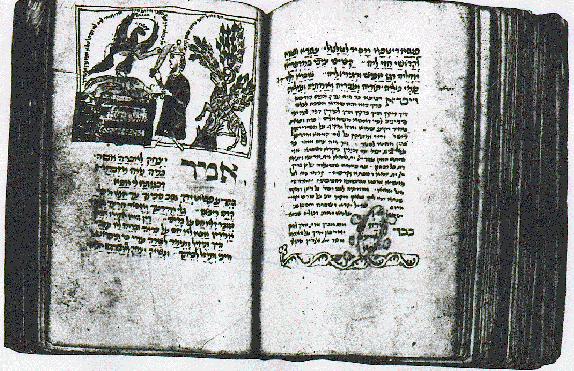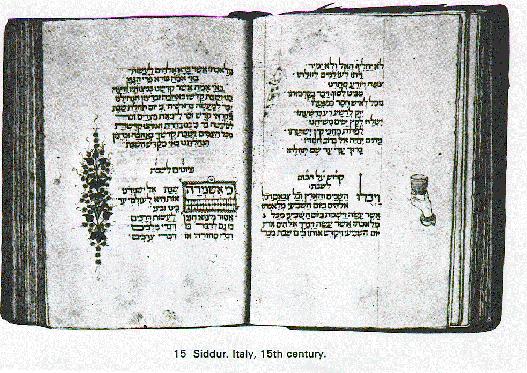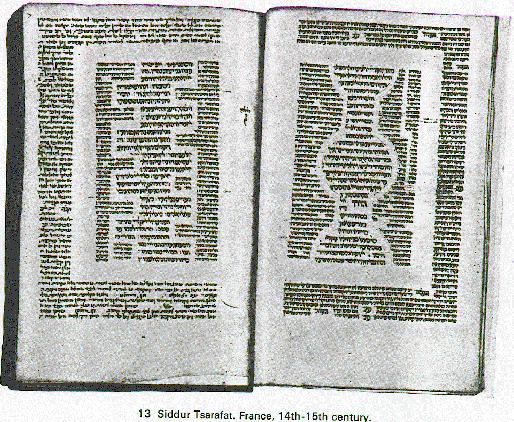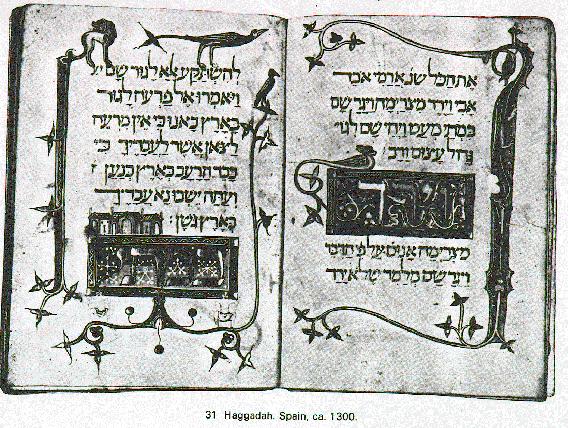Manuscript Collection at the JTSA
Description
- Genizah Manuscripts
The Genizah portion of the JTSA's manuscript collection houses some forty-thousand
works. These works date as far back as 831 C.E. Mostly, they are historical
texts, meant to pass on important elements in Jewish history. A vast majority of the works contain historical accounts of development and sustanance of mediterranean Judaism. The large amount this segment of the manuscript collection was a man named E.N. Adler, purchased by the library in 1923, the result of another proficient campaign by then head librarian Dr. Alexander Marx.

An Austrian Siddur (prayerbook), 1300
- Historical Manuscripts
The historical manuscript collection at the JTSA has been gathered from
disparate communities under great pains. The collection itself is composed
entirely of what are known in hebraic as "Pinkasim." These are tiny books
which contain short stories and histories of the struggles of many European
and Asian Jewish communities. Divided into five subsections, they include
books dating as far back as the 16th century. These sections are...
I) Pinkas Metz (17th
Century)
II) Pinkassim (17th
& 18th Centuries)
III) Pinkas Friedburg
(1563-1580 C.E.)
IV) Pinkas Bamburg (1757-1825
C.E.)
V) Memorbuch (1586-1837
C.E.)
(Special Collections, 29)
- Biblical Manuscripts
The JTS houses about eleven-thousand biblical manuscripts from such disparate
nations as Persia, Yemen, Spain, and Italy. These works include a priceless
Bible illuminated in 1496 by Abraham Farrisol and the Benaim Collection
which contains one-hundred and ten manuscripts reflecting the history of
Judaism in Morroco. All help to illustrate the rich cultural and religious
mileau iwithin which Judaism has developed throught the world.

- History of Science and Medicine Manuscripts
This particular subdivision of the JTSA's manuscript collection houses
just under three-hundred documents and is touted as being one of the most
thourough collections in existance. Focusing on Jewish acheivments in various
areas, it is divided into four smaller sub-groupings. They are...
I) Calendrical,
Astronomical, and Astrological Works
II) Mathematical Works
III) Medical Works
IV) Miscellaneous Works
(Special Collections, 30).
- Kabbalah and Mystical Manuscripts
Kabbalah encompasses the gamut of Hebrew mystical practices and all of
the accoutrements, (tools, instruments, etc...) that accompany it. This
division of the manuscript and rare-book collection is further subdivided
into two categories. The first, simply called "Mysticism," deals entirely
with both the theological and philosophical teachings and applications
of the Hebraic mystical experience. The second grouping, entitled "Kabbalah,"
deals with studies of a more 'mystical' nature , as most people understand
the word (Special Collections, 30). This group has many writings which
attempt to delve into the hidden abstruse meanings of Hebraic mystical
documents. These documents include many genres of writings from poetics
and short-stories to lancient historical letters. Furthermore, it holds
texts and documents devoted to discussing the use of amulets and other
mystical aids.
- Liturgical Manuscripts
This collection of Liturgical manuscripts ihas attained world renown as
being the most thourough ever assembled. Housing some seven-hundred and
fifty documents, texts, and scrolls, the liturgical manuscript collection
was assembled as an attempt to give a cohesive picture of the development
of the itual practices, rites, and liturgies of Judaic communities from
around the world (Special Collections, 30). The communities discussed in
the collection include such disparate lands as Constantinople, Persia,
Algiers, Yemen, and Cochin. Furthermore, some of the most famous manuscripts
ever produced are housed in this area of the collection . These include,
but are not encompasssed by, the Rothschild Mahzor (Florence, 1492), the
Mahzor Vitry (France, 13th Century), and Abraham Farrisol's Mahzor (Italy,
1488).(Special Collections , 31).

- Philological Manuscripts
These manuscripts, as the title of their subdivision implies, deal mainly
with the spicifics of the Hebrew linguistic tradition .(Special Collections,
31). There are a total of one-hundred and fifty manuscripts in this collection.
Highlights of the collection include dictionaries explaining the refrences
in the Talmud and documents studiying the grammatics contained in the Hebrew
language. Varied texts by over forty authors are contained in the collection,
dating as far back as the 11th Century C.E.
- Philosophical Manuscripts
The philosophical subdivision of the JTSA's manuscript assortment includes
well over two-hundred texts of Jewish philosophical teachings and discussions.
Some of the most famous Jewish philosophers and thinkers are represented
in this collection, including Abraham ben David, Maimonides, and Crescas.
Two very famous manuscript collections, namely the Guide to the Perplexed
and the Duties of the Heart are contained here (Special Collections, 31).
- Poetry Manuscripts
Well over three-hundred and fifty dramatic writings, tradgedies, and poems
are held in the poetic division. Some of the most famous Hebrew poets,
writers, and scribes' works can be viewed in thes section of the rare-book
and manuscript collection. These include Immanuel Frances, Shalom Sibzi,
Judah Sommo, and Moses Zacuto. Also included are works by the lesser-emphasized
Jewish writers of history. Showcased here are the writings of Mediterranean
and Arabian peninsula Jewry.
- Polemical Manuscripts
This collection of manuscripts would be of most interest to a student of
Medieval History. Contained here are about seventy manuscripts detailing
the religious and social battles fought by Jews throughout the course of
the Middle Ages. The majority of the texts take on a powerful anti-Christian
tone. Some of the more famous of these works include the Bittul Ikkarei
ha-Nozrim (Hasdai Crescas) and the Hizzuk Emunah (Isaac of Troki). Other
works in the collection are devoted to the recording of many public debates
over Judaism which took place during the Middle Ages. Abraham Farrisol's
Magen Avraham is a prime example of this type of text. Once again, thes
records of these public disputations contain many strong anti-Christian
sentiments.
- Rabbinical Manuscripts
This collection has been touted as the most comprehensive gathering of
Rabbinical texts in the world. It houses some 2,450 manuscripts and rare
books. Everything one could ever possibly want to know about the subject
of Rabbinitivcs is covered in great detail. Of special interest to students
of ancient Hebrew texts is the Yihusei Tannaim we-Amoraim, a comprehensive
collection of the adages of many of the most important and influential
rabbis of the 13th Century.

[back to to JTS Main Page]
[back to Manuscript Introduction]
[back to to Medieval
NewYork]
Site Author: Aaron Herman, Project for "Introduction to
Medieval History", Fordham University, Spring 1997
The Internet History Sourcebooks Project is located at the History Department of Fordham University, New York. The Internet
Medieval Sourcebook, and other medieval components of the project, are located at
the Fordham University Center
for Medieval Studies.The IHSP recognizes the contribution of Fordham University, the
Fordham University History Department, and the Fordham Center for Medieval Studies in
providing web space and server support for the project. The IHSP is a project independent of Fordham University. Although the IHSP seeks to follow all applicable copyright law, Fordham University is not
the institutional owner, and is not liable as the result of any legal action.
© Site Concept and Design: Paul Halsall created 26 Jan 1996: latest revision 12 April 2024 [CV]
|